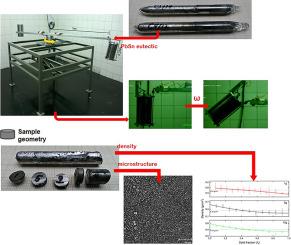The effect of high gravity on the directional solidification of lead-tin (PbSn) eutectic alloy
IF 2.9
Q2 MATERIALS SCIENCE, MULTIDISCIPLINARY
引用次数: 0
Abstract
The eutectic PbSn alloy was directly solidified by vertical gradient freeze technique under high gravity conditions, with gravitational acceleration equal to 1 g, 9 g, and 10 g (where g = 9.81 m/s²). The density of the was determined using Archimedes' principle, and the atomic percentage of solute along the longitudinal direction was estimated using the mixture rule. The cooling data indicated an undercooling phenomenon for samples solidified at high accelerations. Microstructure characterization showed composition differences along the sample length of the samples, attributed to gravity-driven solute sedimentation during solidification. This sedimentation resulted in distinct microstructures: primary and dendritic phases as well as regular and anomalous eutectic structures.

高重力对铅锡共晶合金定向凝固的影响
在重力加速度分别为1 g、9 g和10 g(其中g = 9.81 m/s²)的高重力条件下,采用垂直梯度凝固技术对共晶PbSn合金进行了直接凝固。用阿基米德原理测定了溶液的密度,用混合规律测定了溶质在纵向上的原子百分率。冷却数据表明,在高加速下凝固的样品存在过冷现象。微观结构表征表明,在凝固过程中,由于重力驱动的溶质沉降,沿试样长度方向存在成分差异。这种沉积形成了独特的微观结构:原生相和枝晶相以及规则和异常共晶结构。
本文章由计算机程序翻译,如有差异,请以英文原文为准。
求助全文
约1分钟内获得全文
求助全文
来源期刊

Materialia
MATERIALS SCIENCE, MULTIDISCIPLINARY-
CiteScore
6.40
自引率
2.90%
发文量
345
审稿时长
36 days
期刊介绍:
Materialia is a multidisciplinary journal of materials science and engineering that publishes original peer-reviewed research articles. Articles in Materialia advance the understanding of the relationship between processing, structure, property, and function of materials.
Materialia publishes full-length research articles, review articles, and letters (short communications). In addition to receiving direct submissions, Materialia also accepts transfers from Acta Materialia, Inc. partner journals. Materialia offers authors the choice to publish on an open access model (with author fee), or on a subscription model (with no author fee).
 求助内容:
求助内容: 应助结果提醒方式:
应助结果提醒方式:


